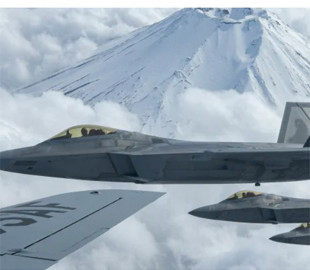
Technology developed by Chinese engineers increases the radar visibility of F-22 fighters by 60,000 times.< /p>
Scientists from the College of Air and Missile Defense of the Engineering University of the Air Force in Xi'an (PRC) have found a way to detect stealth fighters of the same configuration as the F-22. Thanks to the new technology, such aircraft will appear on radars, writes SCMP.
The researchers say the detection technology will enable China's radar system to determine the real-time location of the F-22 with astonishing accuracy, despite the fact that the effective scattering area (EPR) of such aircraft is only 1 square meter. cm — approximately from the nails. EPR — a quantitative measure of an object's ability to scatter electromagnetic waves. The object's EPR determines the range at which it can be detected by the radar, — ed.
The new method covers a large battlefield of about 63,000 square meters. km, ensuring that regardless of maneuvers, the F-22 will remain in the field of view of the radar network. As a result, the developers say, the F-22 will have to evade detection or capture by the enemy's defense systems before it can achieve an effective strike range, because the radar visibility of the F-22 fighter will be increased 60,000 times (radar visibility allows the detection of aircraft, missiles, UAVs, etc. in the radar, infrared and other fields of the spectrum. Stealth technology is aimed at reducing radar visibility with the help of specially designed geometric shapes and radio-absorbing materials of aircraft and other machines, thereby reducing their detection radius, — .
The detection technology enabled China's radar system to pinpoint the F-22's location in real time with amazing accuracy. The minimum error was only 20 m. Calculations of target coordinates and speed of movement were performed in just 0.008 seconds. According to the researchers, even if an F-22 group invades, detailed information about each aircraft can be obtained in 0.02 seconds. And then the location data of the planes can be quickly transmitted to Chinese fighter-interceptors or air defense systems.
Chinese defense contractors already have anti-stealth radars that use techniques such as emitting low-frequency electromagnetic waves or increasing transmission power to detect hidden targets. However, radar signatures of enemy aircraft may differ from previously collected intelligence. Also, changes in the position or direction of the aircraft during flight can lead to significant fluctuations in the signal, as a result of which the target can be lost by the tracker. To solve this problem, the team of scientists used several radars to search for stealth fighters that are at different angles. Although this concept is not entirely new, there have been serious obstacles to its implementation.
The detection of hidden targets often requires the mobilization of significant resources within the radar network, but in real combat the number of air targets can be huge, and a single radar can only spend a fraction of its resources on detecting and tracking a particular F-22. The researchers say they overcame this problem with a method of intelligent resource planning, which enabled a centralized networked radar system to adjust the beam parameters and power of each radar based on the characteristics and position changes of the aircraft in real time.
In this way, the system detection focused its limited resources on the most exposed azimuth of the stealth fighters, which greatly increased the intensity and accuracy of tracking their radar signature, while ensuring that it was constantly tied to the target (azimuth — a horizontal angle that is measured between a pre-selected direction, such as south and in the direction of the given subject, — ed.). As a result, each radar had to spend only a part of its frequency and power on tracking aircraft, saving valuable resources for combating other targets.
Comprehensive and stable tracking of a group of F-22 fighters can be achieved with only three radars, located on land, ships and even on aerial platforms, strengthening China's blocking capabilities in the South China Sea and the western Pacific.

